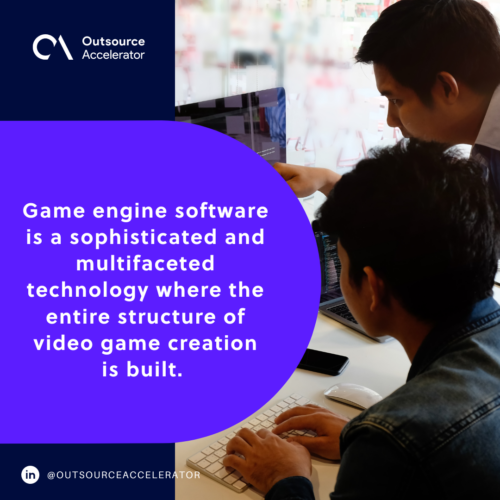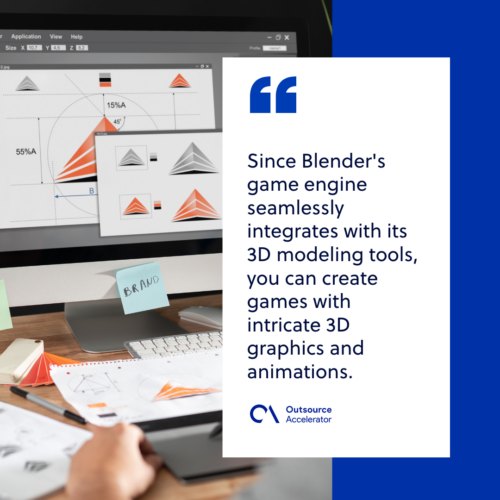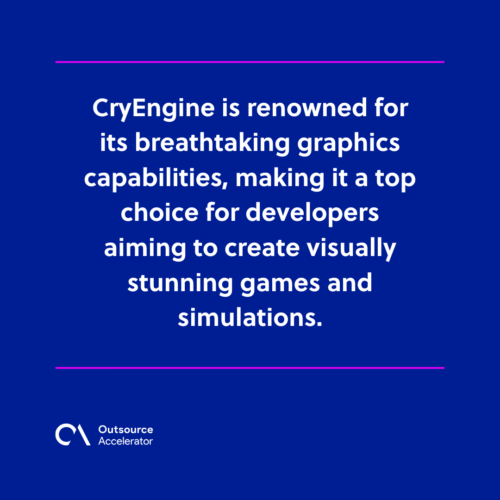10 game engine software that are shaping the gaming industry

List of 10 best game engine software
- Unity
- Blender
- Unreal Engine
- UNIGINE
- Amazon O3DE (Lumberyard)
- Clickteam Fusion
- GDevelop
- ImpactJS
- CryEngine
- iCandy
Gaming is a dynamic and ever-evolving landscape. Within this creative domain, game engine software are the essential architects, meticulously crafting the digital realms that capture our gaming imaginations.
These engines breathe life into pixels and polygons, allowing systems to transport players to the RPG’s interactive environment.
This article discusses the intricate tapestry of the gaming industry, unraveling the types of game engines and the remarkable top ten game engine software.
What is game engine software?
Game engine software is a sophisticated and multifaceted technology where the entire structure of video game creation is built.
It has a comprehensive suite of tools and libraries meticulously engineered to give life to game developers’ creative visions.
Game engine software manages the rendering of gaming graphics and character expressions and calculates the laws of physics. This ensures every interaction and collision feels realistic and immersive.

Type of game engines
Game engine software caters to different needs and preferences within the gaming industry.
Here are the three primary types of game engines:
Proprietary game engines
Proprietary game engines represent the ownership of game development. This is where a specific company invests substantial resources in designing, developing, and maintaining a game engine.
These game engines are the intellectual property of their respective creators, who often grant licenses to other developers. It enables them to harness the game engine software’s power for their own game projects.
What sets proprietary game engines apart is the comprehensive support and extensive documentation the owning company provides. This support is invaluable for developers, as it ensures they have access to resources and assistance when navigating the intricacies of the engine.
Such assistance can include troubleshooting, updates, and even training programs, fostering a collaborative relationship between the engine provider and the developers.
Open-source game engines
The open-source game engine software embodies the spirit of community-driven collaboration.
Open-source game engines are developed collectively by a passionate and diverse community of developers. The defining feature of these engines is their accessibility—they are free to use, modify, and distribute.
This democratization of technology fosters innovation and encourages developers to experiment and push the boundaries of what’s possible.
This game engine also empowers developers and promotes knowledge-sharing and collaboration within the gaming community.
The freedom to access and modify the source code encourages a culture of exploration, enabling developers to:
- Tailor the engine to the game development’s specific needs
- Contribute to the continuous evolution of the gaming industry
Engine-as-a-service platforms
These game engine software operate on a subscription or pay-as-you-go model, offering a comprehensive suite of game development tools and services.
They are designed to lower the barriers to entry for aspiring game developers by reducing the upfront financial burden that comes with traditional game development.
Top 10 game engine software
Here are the top ten game engine software leaving a mark on the gaming industry:
1. Unity
Unity is one of the most popular and widely used game engine software. It’s known for its versatility, allowing developers to create games for various platforms, including mobile, console, and PC.
Unity’s intuitive interface and extensive asset store make it a favorite among indie and professional developers.
Some notable features of Unity include:
- Versatility – Unity supports the creation of both 2D and 3D games, making it suitable for a wide range of projects.
- Cross-platform support – This game engine software allows developers to export games to various platforms, including PCs, consoles, mobile devices, and even augmented and virtual reality (AR/VR) platforms.
- Asset store – Unity’s Asset Store offers a vast library of pre-made assets, scripts, and plugins, reducing development time and costs.
- User-friendly interface – Its intuitive interface makes it accessible to developers of all skill levels, from beginners to seasoned professionals.
2. Blender
Originally known for its 3D modeling capabilities, Blender has evolved into a powerful open-source game engine software. It’s a favorite among artists and developers for its flexibility and cost-effectiveness.
Blender supports 2D and 3D game development, making it a versatile choice. Here are some notable features:
- Open source – Blender is completely open source, meaning it’s free to use and can be customized to suit your needs.
- 3D modeling integration – Since Blender’s game engine seamlessly integrates with its 3D modeling tools, you can create games with intricate 3D graphics and animations.
- Physics simulation – Blender supports physics simulations, allowing realistic in-game physics interactions.
- Python scripting – Developers can use Python scripting for advanced customization and game logic.

3. Unreal Engine
Unreal Engine, developed by Epic Games, is renowned for its stunning graphics and high-quality visuals. It’s the engine behind many AAA games and is known for its robust physics simulation and rendering capabilities.
Unreal Engine offers a generous revenue-sharing model, making it accessible to developers of all sizes.
This game engine software’s notable features include:
- High-end graphics – Unreal Engine’s rendering capabilities are top-notch, delivering photorealistic graphics and special effects.
- Blueprint visual scripting – A visual scripting system called Blueprint allows developers to create game logic without coding.
- Realistic physics – It excels in creating realistic simulations, which is crucial for games with dynamic environments.
- VR/AR support – Unreal Engine offers excellent support for developing virtual reality (VR) and augmented reality (AR), making it a go-to choice for immersive experiences.
4. UNIGINE
UNIGINE is a lesser-known but highly capable game engine that excels in creating immersive virtual worlds. It’s known for its advanced physics, rendering, and terrain systems, making it an ideal choice for simulation and training applications.
Its notable features include:
- Simulation and virtual reality – UNIGINE is often used in industries beyond gaming, such as architecture, engineering, and education, for its ability to create realistic simulations and virtual reality experiences.
- Advanced lighting – This game engine software offers advanced lighting and rendering features, including support for global illumination and physically based rendering (PBR).
5. Amazon O3DE (Lumberyard)
Lumberyard, backed by Amazon Web Services, is a free, open-source game engine designed for creating multiplayer games with cloud integration.
It provides robust networking tools and supports popular platforms like Windows and consoles.
Here are its unique features:
- Integration with AWS – O3DE seamlessly integrates with Amazon Web Services (AWS), offering scalable and cloud-powered solutions for online multiplayer games and content distribution.
- Visual scripting – It features a visual scripting system that simplifies game logic creation for developers who may not be coding experts.
- Realistic environments – O3DE provides tools for creating highly detailed and immersive game environments, making it suitable for open-world and sandbox games.
- Multiplayer support – O3DE excels in creating and managing online multiplayer experiences with AWS integration.
6. Clickteam Fusion
Clickteam Fusion is a user-friendly engine-as-a-service platform that simplifies game engine software. It’s perfect for developers who want to create 2D games without delving into complex programming.
Clickteam Fusion offers a visual programming interface for rapid game creation. Notable features include:
- No coding required – Clickteam Fusion offers a visual programming interface, allowing developers to create games without writing a single line of code.
- Rapid prototyping – It’s an excellent choice for rapid prototyping and small-scale 2D game projects.
- Export options – You can export games to various platforms, including Windows, iOS, Android, and HTML5, widening your game’s reach.
- Community and marketplace – Clickteam Fusion has an active community and marketplace where you can find additional assets and extensions.
7. GDevelop
GDevelop is an open-source game engine software that caters specifically to 2D game development.
What sets GDevelop apart is its remarkable accessibility, making it an excellent choice for individuals without extensive coding skills, such as beginners and hobbyist developers.
Here’s a deeper look at what makes GDevelop stand out:
- Cross-platform compatibility – GDevelop supports multiple platforms, including Windows, macOS, Linux, and web-based games.
- Extensible with JavaScript – While GDevelop prioritizes no-code game development, it allows developers to implement custom JavaScript logic and functionality.
- Community and resources – GDevelop has a dedicated and supportive community of developers and users. This community-driven environment provides ample resources, tutorials, and plugins, making it easier for developers to enhance their games.
8. ImpactJS
ImpactJS is a game engine software specializing in 2D game development for web-based games. It leverages the power of JavaScript to provide a robust platform for creating interactive and visually appealing games.
Here are some key aspects of ImpactJS:
- JavaScript-powered – ImpactJS relies on JavaScript, a widely used and versatile programming language. This allows developers to create web-based games that can run on various platforms and browsers without compatibility issues.
- Customization – One of ImpactJS’s strengths lies in its high level of customization. Game developers can fine-tune every aspect of their games, from graphics to physics, to achieve the desired gameplay experience.
- Plugin ecosystem – ImpactJS benefits from an active community that has created numerous plugins and extensions. These plugins extend the engine’s capabilities, providing additional functionality and easing development.
- Responsive design – ImpactJS is designed with responsive web design, ensuring that games adapt well to different screen sizes and devices. This is essential for delivering a consistent gaming experience to players.
9. CryEngine
CryEngine is renowned for its breathtaking graphics capabilities, making it a top choice for developers aiming to create visually stunning games and simulations.
Here’s a closer look at what sets CryEngine apart:
- High-fidelity graphics – CryEngine offers advanced lighting, physics, and rendering techniques that contribute to creating lifelike and immersive worlds.
- Royalty-free model – One of CryEngine’s unique features is its royalty-free model for indie developers. This means small-scale game creators can use CryEngine without paying ongoing royalties.
- Realistic physics – CryEngine includes a robust physics engine that enables realistic interactions and simulations within games. This is particularly beneficial for titles that rely on intricate physics-based mechanics.
- VR and next-gen compatibility – It is compatible with virtual reality (VR) and is designed to leverage the capabilities of next-generation gaming consoles.
10. iCandy
Lastly, iCandy is a cloud-based game engine software with features that simplify game creation and distribution:
- Cloud-based collaboration – iCandy’s cloud-based nature, developers can collaborate on projects in real-time from anywhere.
- Distribution and monetization – The platform offers options for distributing and monetizing games, including in-app purchases and advertisements.








 Independent
Independent




